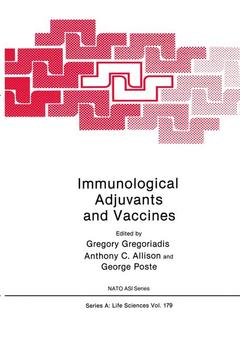Description
Immunological Adjuvants and Vaccines, 1989
NATO Science Series A: Series, Vol. 179
Coordinators: Gregoriadis Gregory, Allison Anthony C., Poste George
Language: English
Subjects for Immunological Adjuvants and Vaccines:
Keywords
Antigen; DNA; gene expression; infectious disease; interferon; proteins
Publication date: 12-2012
244 p. · 17.8x25.4 cm · Broché
244 p. · 17.8x25.4 cm · Broché
Vaccination, chiefly responsible for the eradication of smallpox and the control of poliomyelitis and German measles in man and of foot-and mouth, Marek's and Newcastle disease in domestic animals, remains the best answer to infectious diseases. Early vaccines were live wild type organ isms but these have been largely replaced by attenuated or killed organisms or by purified components (subunits) thereof. More recently, developments in recombinant DNA techniques, the advent of monoclonal antibodies and progress in our understanding of the immunological structure of proteins, have laid the foundations for a new generation of vaccines. For instance, subuni t vaccines have been produced through gene cloning and a number of peptides mimicking small regions of proteins on the outer coat of viruses and capable of eliciting virus neutralizing antibodies, have been synthes ized. Such vaccines are defined at the molecular level, can elicit immune responses controlling specific infectious organisms and are, thus, potent ially free of the problems inherent in conventional ones. However, because subunit and peptide vaccines are only weakly or non-immunogenic, they re quire the presence of immunological adjuvants. These are a diverse array of agents that promote specific humoural and/or cell-mediated immunity responses to antigens. This book contains the proceedings of the 1st NATO Advanced Studies Institute "Immunological Adjuvants and Vaccines" held in Cape Sounion Beach, Greece during 24 June-5 July, 1988.
Antigens and Adjuvants for a New Generation of Vaccines.- Structural and Functional Studies on MHC-Peptide Antigen Interactions.- Role of Interferon Gamma in the Priming of Human Accessory Cells for Autocrine Secretion of Monokines (IL-1 and TNF) and HLA Class II Gene Expression.- Chemical Events in Immune Induction: Evidence for a Covalent Intercellular Reaction Essential in Antigen-specific T-cell Activation.- Aluminium Salts: Perspectives in their Use as Adjuvants.- Saponins as Immunoadjuvants.- The Immunoadjuvant Dimethyldioctadecylammonium Bromide.- Bacterial Endotoxins: Relationships between Chemical Structure and Biological Activity.- Recombinant Gamma Interferon as an Immunological Adjuvant.- The Immunoadjuvant Action of Liposomes: Role of Structural Characteristics.- Immunoadjuvant Action of Liposomes: Mechanisms.- Liposomal Vaccine to Streptococcus Pneumoniae Type 3 and 14.- Liposomes as Carriers of Vaccines: Development of a Liposomal Malaria Vaccine.- Nonionic Block Copolymer Surfactants as Immunological Adjuvants: Mechanisms of Action and Novel Formulations.- Use of Syntex Adjuvant Formulation to Augment Humoral Responses to Hepatitis B Virus Surface Antigen and to Influenza Virus Hemagglutinin.- Immunostimulating Complex (Iscom).- Recombinant Sub-unit and Peptide Viral Vaccines.- Synthetic Antigens and Vaccines.- The Development and Preliminary Clinical Evaluation of an Antifertility Vaccine.- Recent Progress with Vaccines against Epstein-Barr Virus Infection.- Measurement of Antibody Affinity, Concentration and Isotype to Evaluate Antigens, Adjuvants, and Immunization Regimens in Vaccine Research.- Recommendations for the Assessment of Adjuvants (Immunopotentiators).- Interaction between Industry and the Basic Researcher in the University during Vaccine Development.- Contributors.
© 2024 LAVOISIER S.A.S.




